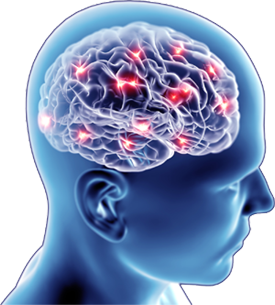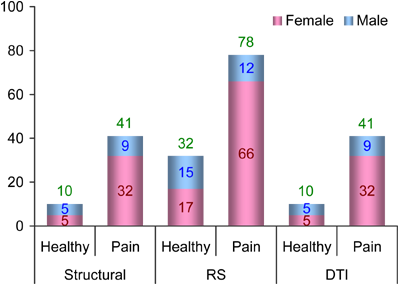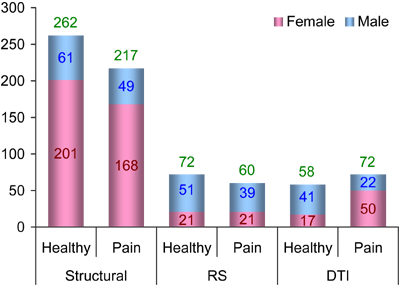| Issue 1.2 — Fall 2014 | |
 |
In This Issue
|
| Message from Emeran A. Mayer – Chair, Executive Committee | |
|
Welcome to the second issue of the PAIN Repository Newsletter. We are excited that only in its second year, the repository has steadily grown to a total of nearly 1,000 scans due to the efforts of the PAIN support team and the willingness of a growing number of members to upload scans. The PAIN Repository now contains multimodal scans from several chronic pain conditions, including low back pain, vulvodynia, and IBS with efforts under way to expand this list to include migraine headaches, TMJD and Bladder Pain Syndrome/Interstitial Cystitis. An effort led by a group of PAIN members with an interest in IBS has started to analyze all IBS data in the repository’s archive. Additional efforts are under way to add the collection of gut microbiome data to the IBS portion of the repository for future correlational analyses of gut microbiota and brain. Finally, I would like to draw attention to the fact that the PAIN repository will provide a unique opportunity to address the important issue of studying sex-related differences in chronic pain conditions. The study of sex related differences has been identified as a requirement for all NIH funded studies. While individual studies often do not have the adequate sample size to compare male and female subjects, the rich data set that is accumulating in the PAIN repository greatly facilitates this important aspect of pain research. If you haven’t signed up as a member, or if you are a member and have been too busy to upload your existing scans, please check the PAIN website or contact the PAIN support team. |
|
| News Bites | |
|
We are growing! Since its inception in January 2014, the PAIN Repository has experienced rapid and continuous growth. The archived repository currently stores structural, resting state and DTI scans totaling 741 on several pain conditions, including chronic back pain, vulvodynia and irritable bowel syndrome. The Standardized repository contains 212 scans. All scans are available to investigators who are contributing members of PAIN. Keystone Symposium – The Brain: Adaptation and Maladaptation in Chronic Pain The Keystone Meeting brought good interactions between the PAIN team and current and prospective members this past June. The goal of this conference was to bring together the world’s leading experts in brain systems neuroscience to highlight the advances in understanding brain systems relevant to the neurobiology of migraine and chronic pain. Several PAIN members gave presentations at this 6 day event. Speakers included David Borsook, Vania Apkarian, Herta Flor and Emeran Mayer. Upcoming IASP Meeting We are looking forward to attending the 15th World Congress on Pain in Buenos Aires from October 6-11, 2014. The PAIN team will be presenting a poster on the Repository (#PH206) on Thursday October 9 from 9:30-10:30 am. Emeran Mayer, Lisa Kilpatrick and Jennifer Labus from UCLA will be attending the event and can answer any questions you may have on the Repository. |
|
| Current Data | |
|
Our growing body of data contains structural and functional brain scans from patients with chronic pain conditions and healthy controls contributed by members and available for analysis.In addition, the PAIN Standardized Repository also offers clinical, psychosocial and behavioral data. The Executive Committee evaluates all requests for data, and encourages collaborations among multiple researchers and institutions. Current pain conditions include: irritable bowel syndrome (IBS), vulvodynia (Vlvd), chronic back pain (CBP), inflammatory bowel disease (IBD) |
|
|
Standardized Repository Standardized Structural Scans: 51 Standardized Resting State Scans: 110* Standardized DTI Scans: 51* |
 |
|
Archived Repository Structural Scans: 479 Resting State Scans: 132* DTI Scans: 130* |
 |
| * All requested resting state and DTI scans will be accompanied by a structural scan for co-registration. Standardized resting state and DTI scans may be accompanied by a structural scan not acquired using standardized parameters but meets the needs for co-registration. | |
| Funding Opportunities | |

The National Institutes of Health (NIH) currently has multiple Big Data funding opportunities that can benefit pain researchers, particularly with training and educational activities.
|
|
| Recent Relevant Publications | |
|
Changes in Clinical Pain in Fibromyalgia Patients Correlate with Changes in Brain Activation in the Cingulate Cortex in a Response Inhibition Task Schmidt-Wilcke T, Kairys A, Ichesco E, Fernandez-Sanchez ML, Barjola P, Heitzeg M, Harris RE, Clauw DJ, Glass J, Williams DA. Pain Med. 2014 Aug;15(8):1346-58. The primary symptom of fibromyalgia is chronic, widespread pain; however, patients report additional symptoms including decreased concentration and memory. Performance-based deficits are seen mainly in tests of working memory and executive functioning. It has been hypothesized that pain interferes with cognitive performance; however, the neural correlates of this interference are still a matter of debate. In a previous, cross-sectional study, we reported that fibromyalgia patients (as compared with healthy controls) showed a decreased blood oxygen level dependent (BOLD) response related to response inhibition (in a simple Go/No-Go task) in the anterior/mid cingulate cortex, supplementary motor area, and right premotor cortex. In this longitudinal study, neural activation elicited by response inhibition was assessed again in the same cohort of fibromyalgia patients and healthy controls using the same Go/No-Go paradigm. Go to journal site to read more |
|
| Call for Papers | |
|
Recent Advances and Challenges on Big Data Analysis in Neuroimaging Frontiers in Neuroscience – Brain Imaging Methods Deadline for abstract submission: October 15, 2014 Key breakthroughs in the development of effective treatment of neurological and psychiatric disease will require innovative techniques to enable scientists to record and analyze signals from 100 billion neurons in brain in much larger numbers and at even faster speeds. These neuroscience methods usually generate huge volumes of data with often many terabytes involving various high resolution imaging modalities (fMRI, PET, DTI, EEG, etc.) Thus, the efficient analysis of big data and the development of high-performance computing tools become critical to neuroscience. The goal of this topic is to provide a forum for researchers to contribute their investigations on statistical challenges and approaches to exploring the mystery of the human brain using big data. Learn more |
| PAIN Repository FAQ – New Additions | |||||||||||||||||||
| Q | Can I use the new Multi-Band Accelerated Pulse Sequence for the Standardized Repository? | ||||||||||||||||||
| A | 
The PAIN Repository will accept diffusion and resting state fMRI scans acquired using the new Multi-Band Accelerated Pulse Sequences developed by the Center for Magnetic Resonance Research at the University of Minnesota. However, currently, these sequences have been developed for the Siemens scanners only. These are available via a free license from UMN CMRR: https://www.cmrr.umn.edu/multiband. If you choose to use these new settings, please coordinate with the PAIN Team regarding the specific scanner, software version, and sequence used. The Repository will continue to accept scans based on the current standardized protocols. Due to the uncertainty regarding if and how these scans will be combinable with scans acquired using the standardized protocols, we encourage you to acquire scans using both sequences if possible. |
||||||||||||||||||
|
|||||||||||||||||||
| The Oppenheimer Center for Neurobiology of Stress at UCLA CHS 42-210 MC737818 10833 Le Conte Avenue Los Angeles, CA 90095-7378 Phone: (310) 206-0192 info@painrepository.org |
|||||||||||||||||||
